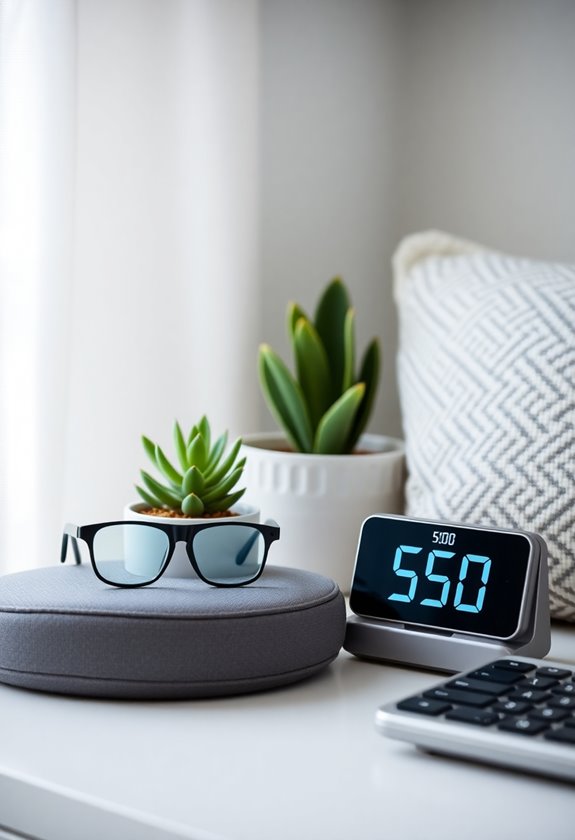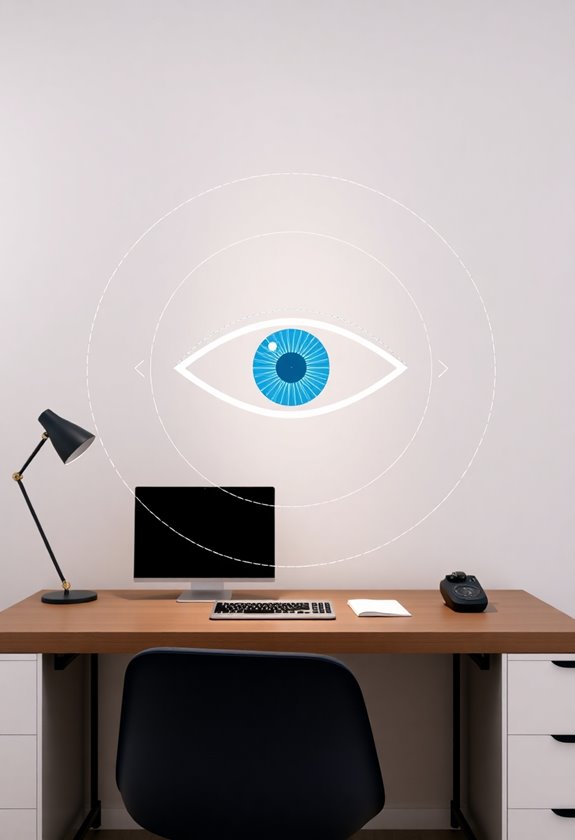You can prevent computer eye strain with a simple 5-minute exercise routine throughout your workday. Start with the 20-20-20 rule: every 20 minutes, look at something 20 feet away for 20 seconds. Follow this with eye rolls in both directions and gentle blinking exercises to reduce dryness. Position your screen arm's length away and slightly below eye level, keeping brightness matched to your surroundings. Take regular breaks to palm your closed eyes while breathing deeply, and maintain proper hydration. These foundational steps will help protect your vision, but there's much more you can do to enhance your eye health.
Highlights
- Practice the 20-20-20 rule: every 20 minutes, look at something 20 feet away for 20 seconds to relax eye muscles.
- Roll eyes clockwise and counterclockwise five times each while keeping your head still to reduce muscle tension.
- Close eyes tightly for three seconds, then open wide for three seconds, repeating ten times to refresh tired eyes.
- Look up, down, left, and right, holding each position for two seconds and repeat five times for muscle flexibility.
- Place warm palms over closed eyes for 30 seconds while taking deep breaths to reduce eye strain.
The Science Behind Digital Fatigue

Nearly every digital device user experiences computer vision syndrome, a condition where prolonged screen time strains the eyes and causes discomfort. When you're staring at screens, you're forcing your eyes to focus intensely on pixels while reducing your natural blink rate by up to 66%, which leads to dry, irritated eyes.
Your eyes weren't designed for constant near-focus work, and digital screens present unique challenges that can trigger various symptoms:
- Blue light emission disrupts your natural sleep-wake cycle
- Constant refocusing between screen distances strains eye muscles
- Screen glare and poor contrast force your eyes to work harder
- Improper viewing angles create neck strain that compounds eye fatigue
These factors combine to create what's known as digital fatigue, affecting your productivity and overall eye health.
Quick Relief Eye Exercises

During the workday, you can quickly relieve eye strain with simple exercises that take just minutes to perform. These targeted movements help reduce fatigue and tension while promoting better blood circulation to your eye muscles and supporting tissues.
- Focus on an object 20 feet away for 20 seconds, then shift your gaze to something close for another 20 seconds, repeating this cycle three times
- Roll your eyes clockwise slowly five times, then counterclockwise five times, keeping your head still
- Close your eyes tightly for three seconds, then open them wide for three seconds, repeating ten times
- Place your warm palms over closed eyes for 30 seconds while taking deep breaths
- Look up and down, then left and right, holding each position for two seconds, repeating five times
Workspace Setup For Eye Health

A properly configured workspace can considerably reduce computer-related eye strain and prevent long-term vision problems. Here's how to optimize your setup for better eye health:
- Position your monitor at arm's length (20-28 inches) from your eyes, with the screen's top edge slightly below eye level.
- Confirm your screen brightness matches your surroundings, and adjust your room's lighting to minimize glare and reflections on your display.
- Place any reference materials between your keyboard and monitor using a document holder, which helps maintain proper neck position while reducing eye movement.
- If you're using a laptop, consider connecting an external monitor at the proper height, as looking down at a laptop screen can strain both your eyes and neck.
- Keep your desk organized with frequently used items within arm's reach to prevent unnecessary eye focusing adjustments.
Consider using a standing desk converter to adjust your monitor height throughout the day, which can help maintain optimal viewing angles as you switch between sitting and standing positions.
Lifestyle Changes That Help

Making lifestyle adjustments outside your workspace can greatly reduce computer-related eye strain. You'll find that incorporating healthy habits into your daily routine will protect your vision while strengthening your overall eye health, especially when you're spending long hours in front of digital screens.
- Get at least 7-8 hours of quality sleep each night to allow your eyes proper recovery time
- Maintain proper hydration by drinking 8-10 glasses of water daily to prevent dry eyes
- Include foods rich in vitamins A, C, and E, plus omega-3 fatty acids in your diet
- Schedule regular thorough eye exams to monitor your vision health
- Spend at least 30 minutes outdoors daily to help your eyes adjust to natural light and different focal lengths
Essential Screen Time Habits

While lifestyle changes support long-term eye health, your daily screen habits have the most direct impact on preventing eye strain. You'll need to implement the 20-20-20 rule: look at something 20 feet away for 20 seconds every 20 minutes of screen time.
Position your screen about arm's length away and slightly below eye level, ensuring your monitor's brightness matches your surrounding environment. You should adjust your screen's text size and contrast for comfortable reading without squinting or leaning forward. Don't forget to blink frequently, as studies show we blink less when using digital devices. Keep your screen clean from dust and fingerprints, which can create glare and make your eyes work harder to focus. If you're using multiple screens, arrange them at equal distances to minimize eye movement and refocusing.
Frequently Asked Questions
Can Eye Strain From Computer Screens Cause Permanent Damage to Vision?
While computer eye strain won't cause permanent damage to your vision, it can lead to significant temporary discomfort and fatigue. You'll typically experience symptoms like dry eyes, blurred vision, and headaches that resolve after taking breaks from screen time. If you're concerned about ongoing symptoms, it's best to consult an eye doctor who can evaluate your specific situation and recommend appropriate solutions.
How Often Should I Get My Eyes Checked if I Work on Computers?
If you're glued to screens all day like a digital warrior, you should get thorough eye exams annually to protect your vision's frontline. However, if you're over 40 or have existing vision problems, schedule check-ups every six months since your eyes become more vulnerable to strain and changes. Don't wait for symptoms to appear – regular visits to your eye care professional help catch potential issues before they become serious problems.
Are Blue Light Glasses Worth the Investment for Preventing Eye Strain?
While blue light glasses can help reduce digital eye strain, research on their effectiveness is mixed. You'll find the most benefit if you're using screens at night, as they may help regulate your sleep cycle. For daytime computer work, you'll get better results from practicing the 20-20-20 rule and maintaining proper screen distance than relying solely on blue light glasses as your primary eye strain solution.
Which Monitor Resolution and Refresh Rate Are Best for Reducing Eye Fatigue?
For ideal eye comfort, you'll want a monitor with at least 2560 x 1440 (QHD) resolution and a minimum 75Hz refresh rate. Higher resolutions reduce pixel visibility and eye strain, while faster refresh rates create smoother motion that's easier on your eyes. When you're working with text, a 4K display (3840 x 2160) will give you the sharpest clarity, and a 144Hz refresh rate will minimize motion blur during scrolling.
Do Contact Lens Wearers Experience More Computer Eye Strain Than Others?
If you wear contact lenses, you're likely to experience more digital eye strain than non-wearers because contacts can become dry and uncomfortable during long screen sessions. Your eyes naturally blink less when looking at screens, which reduces the moisture needed to keep contacts comfortable. You'll need to be extra vigilant about taking breaks, using artificial tears, and following the 20-20-20 rule to prevent discomfort and potential eye health issues.




